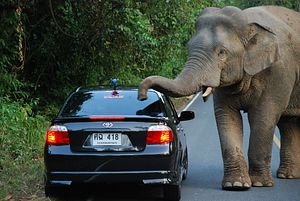A three-tonne elephant attempted to cross the road in mid-August in Chonburi Province just two hours outside of Bangkok when she was struck by an 18-wheeler. Her back broken, a crane lifted her into a truck to transport her to a hospital in Nakhon Pathom. She was seven years old. With only 3,000 wild elephants left in the Land of Smiles, losses like this are tragic — though perhaps preventable.
“Incidents of elephants getting hit happen from time to time, as some of the elephant movement areas have been converted to development areas, including roads,” says Dr. Arnold Sitompul, WWF Thailand conservation director. “New infrastructure development certainly needs to take wildlife movement as a critical factor.”
The number of elephants hit each year by cars varies, but organizations like the WWF are taking action in Thailand’s national parks by collaring and tracking elephants to prevent violent interactions with large herds, but individual elephant car strikes are harder to foresee.
“In Ang Re Nai, for example, we have collared two individual elephants from two different groups to understand their movement so we can anticipate the HEC (human elephant conflict) before it becomes massive,” says Sitompul, adding that they are aiming to collar four more elephants in a separate group to get more information. “This preventive measure has been quite successful to reduce the scale of HEC in the community areas.”
“In the context of elephants getting killed by cars, sometimes it is unavoidable, as they are constantly moving,” says Sitompul, adding that the Department of National Parks, Wildlife and Plant Conservation (DNP) has been working hard to put elephant signs on the main roads so that drivers will be aware of the potential elephant crossings.
It’s not just the elephants that are in danger when it comes to road accidents; run-ins with elephants in Thailand’s national parks have killed drivers as well. Motorcyclists in particular face serious danger from elephants. And after a car struck an elephant in March of 2018, the enraged elephant stomped the car and the driver. Perhaps the deadliest elephant incident in recent memory was a 2014 three-car pile-up that killed six people. However, in a country with the deadliest roads in Asia, elephants are not the highest priority.
Long-term solutions may require more severe measures than road signs, namely, wildlife corridors. While there are many Asian elephants to be found in Thailand’s empty north, it is in the southern areas that seem to be in most danger of human and elephant incidents. The growth of the human population shows no sign of slowing any time soon. Protecting the largest land mammal in Asia requires building wildlife corridors that allow the animals to roam more freely.
“Generally, we are seeing an increase of elephants coming out of national parks to look for food in numerous areas around Thailand,” says Tom Taylor with the Wildlife Friends Foundation of Thailand. “Populations of elephants are growing inside the national parks, and obviously more elephants require more food.”
The Wildlife Friends Foundation of Thailand is found near one of the lesser visited areas of Thailand: Kaeng Krachan. With fewer facilities than somewhere like Khao Yai and little in the way of public transport, Kaeng Krachan is a less disturbed corner of Thailand, the largest of its national parks and with a healthy and growing wild Asian elephant population of approximately 300.
“One of the affected parts of Kaeng Krachan is a road through Sector 5 (the Pala-U area). That’s a problem area. It goes right through wild elephant habitat,” Taylor says. “There are signs, warnings, but cars go through there going 100 kilometers an hour. To me it makes sense to divert the traffic; there’s no reason for it to go directly through that habitat. It’s like that in Khao Yai, where idiots go through 100 kilometers an hour on motorbikes through prime rainforest.”
A large-project corridor that would allow these parks to connect would link Kaeng Krachan to Kui Buri, which has around 250 elephants, just a few dozen kilometers south. “Between Kaeng Krachan and Kui Buri National Park there isn’t a direct line — a wildlife corridor — […] between those two national parks. There should be,” Taylor says. “It’s a native habitat and on the Burmese side there are also national parks.”
Whereas Khao Yai, a convenient weekend getaway for Bangkok city folk, is entirely surrounded by cultivation, Kaeng Krachan park goes all the way to Myanmar and presents a number of challenges for wildlife enforcement. In a widely reported case in 2013, a palm oil farmer’s fence electrocuted a seven year old elephant to death.
There are no actionable official plans to build a wildlife corridor from Kaeng Krachan to Kui Buri, but the kingdom has seen recent success with wildlife corridors east of Bangkok on Highway 304, linking Nakhon Ratchasima and Prachin Buri. The road has taken a brutal toll on the wildlife of one of Thailand’s most famous forests, but the wildlife corridor links Khao Yai and Thap Lan national parks to the benefit of all the wildlife of the region, not just elephants. These projects, however, do not come cheap, with the Nakhon Ratchasima and Prachin Buri corridor costing 9 billion baht ($293.5 million)
Human-elephant interactions may well be a permanent facet of life in certain areas — and this is not just a Thailand problem. “The [Elephant car crash] is common to most Asian elephant range states including, India, Malaysia, Indonesia, and many others. This situation has certainly increased the number of human elephant conflicts.” Most recently, concerns about the Pan Borneo Highway in Malaysia’s state of Sabah has caused serious concerns from environmental groups, saying it poses a risk to elephants, orangutans, and proboscis monkeys.
“In the area where the roads already exist, then physical corridors need to be developed so the elephant can cross the road or railway in safer way,” says Sitompul. “But there is still no guarantee of zero incidents.”

































